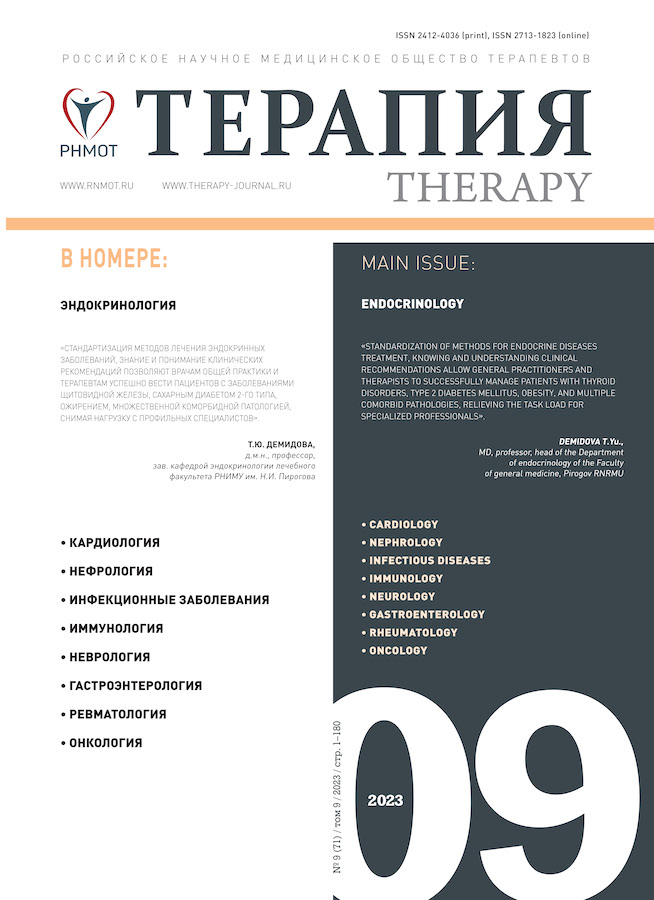Influence of obesity at frailty syndrome manifestations in persons over 75 years old
- Authors: Evgenieva A.V.1, Noskov S.M.1, Zhomova M.V.1, Lavrukhina A.A.1
-
Affiliations:
- Yaroslavl State Medical University of the Ministry of Healthcare of Russia
- Issue: Vol 9, No 9 (2023)
- Pages: 80-85
- Section: ORIGINAL STUDIES
- URL: https://journals.eco-vector.com/2412-4036/article/view/626134
- DOI: https://doi.org/10.18565/therapy.2023.9.80-85
- ID: 626134
Cite item
Abstract
Implementation of measures to identify individuals with signs of frailty syndrome (FS) helps preserve cognitive functions and functional independence of patients.
The aim: to determine the role of obesity as a predictor of decreased physical and functional activity, as well as cognitive impairment in persons over 75 years old.
Material and methods. 40 patients (19 males and 21 females) aged 80,2±3,8 years were included in the study. They were divided into two groups: 17 (42,5%) persons with BMI <30 (25,8±2,1 kg/m2) and 23 (57,5%) with obesity (BMI 33,2±2,9 kg/m2).The probability of FS was assessed using the «Age is not a barrier» questionnaire, Morse scale, cognitive status was assessed according to MINI-COG, MMSE criteria. All patients underwent muscle strength assessment: dynamometry values <16 daN in females and <27 daN in males were taken as a symptom of probable sarcopenia.
Results. Risk of FS developing according to the «Age is not a barrier» questionnaire and the Morse scale was 40 and 71,2% higher among individuals with obesity. According to MINI-COG, 3 patients (17,6%) scored <3 points (one of the signs of dementia) in the group with BMI <30 kg/m2, while in the obese group – 8 patients (34,8%). Among persons with BMI <30 kg/m2, manifestations of mild dementia according to MMSE were observed in 4 (23,6%), moderate – in 5 (29,4%) cases; in obese patients they were more common – in 9 (39,2%) and 7 (30,5%) cases, respectively. Low indexes of dynamometry in the group with BMI <30 kg/m2 were fixed in 8 persons (23,6±0,15 kg), in the obese group – in 19 persons(19,8±0,9 kg). Moreover, all patients with a high risk of falls according to the Morse scale (≥51 points) and dementia disorders according to the MMSE had a decrease in muscle strength. A positive correlation of BMI with Morse scale scores was revealed (r=0,49, p <0,05) both with inverse correlation between BMI and MMSE data (r=-0,56, p >0,05). There was an inverse correlation between dynamometry indexes and the age of patients (r=-0,53, p <0,05), as well as BMI (r=-0,42, p <0,05).
Conclusion. A significant decrease in the level of functional activity, muscle strength and cognitive status was found among elderly patients with obesity. This can be explained by the development of «sarcopenic obesity» in them, when excess body weight masks a lack of muscle mass, which is confirmed by dynamometry data.
Keywords
Full Text
About the authors
Alexandra V. Evgenieva
Yaroslavl State Medical University of the Ministry of Healthcare of Russia
Author for correspondence.
Email: a-evgenyeva@yandex.ru
PhD in Medical Sciences, Assistant at the Department of Hospital Therapy with Occupational Pathology
Russian Federation, YaroslavlSergey M. Noskov
Yaroslavl State Medical University of the Ministry of Healthcare of Russia
Email: noskov03@gmail.com
MD, Professor of the Department of Hospital Therapy with Occupational Pathology
Russian Federation, YaroslavlMaria V. Zhomova
Yaroslavl State Medical University of the Ministry of Healthcare of Russia
Email: mariazhomova@rambler.ru
PhD in Medical Sciences, Assistant at the Department of Hospital Therapy with Occupational Pathology
Russian Federation, YaroslavlAlina A. Lavrukhina
Yaroslavl State Medical University of the Ministry of Healthcare of Russia
Email: alinalavr@gmail.com
PhD in Medical Sciences, Associate Professor of the Department of Hospital Therapy with Occupational Pathology
Russian Federation, YaroslavlReferences
- Ткачева О.Н., Котовская Ю.В., Рунихина Н.К. с соавт. Клинические рекомендации «Старческая астения». Российский журнал гериатрической медицины. 2020; (1): 11–46. [Tkacheva O.N., Kotovskaya Yu.V., Runikhina N.K. et al. Clinical guidelines on frailty. Rossiyskiy zhurnal geriatricheskoy meditsiny = Russian Journal of Geriatric Medicine. 2020; (1): 11–46 (In Russ.)]. https://dx.doi.org/10.37586/2686-8636-1-2020-11-46. EDN: JCMOSK.
- Остапенко В.С. Распространенность и структура гериатрических синдромов у пациентов амбулаторно-поликлинических учреждений г. Москвы. Авторефер. дис. канд. мед. наук. М.: 2017; 24 с. Доступ: https://www.dissercat.com/content/rasprostranennost-i-struktura-geriatricheskikh-sindromov-u-patsientov-ambulatorno-poliklinic (дата обращения – 01.11.2023). [Ostapenko V.S. Prevalence and structure of geriatric syndromes in patients of outpatient clinics in Moscow. Abstract of the dissertation for an academic degree PhD in Medical Sciences. Moscow. 2017; 24 pp. URL: https://www.dissercat.com/content/rasprostranennost-i-struktura-geriatricheskikh-sindromov-u-patsientov-ambulatorno-poliklinic (date of access – 01.11.2023) (In Russ.)].
- Yu S.C., Khow K.S., Jadczak A.D., Visvanathan R. Clinical screening tools for sarcopenia and its management. Curr Gerontol Geriatr Res. 2016; 2016: 5978523. https://dx.doi.org/10.1155/2016/5978523.
- Stessman J., Jacobs J.M., Ein-Mor E., Bursztyn M. Normal body mass index rather than obesity predicts greater mortality in elderly people: The Jerusalem longitudinal study. J Am Geriatr Soc. 2009; 57(12): 2232–38. https://dx.doi.org/10.1111/j.1532-5415.2009.02567.x.
- Мисникова И.В., Ковалева Ю.А., Климина Н.А. Саркопеническое ожирение. РМЖ. 2017; 25(1): 24–29. [Misnikova I.V., Kovaleva Yu.A., Klimina N.A. Sarcopenic obesity. Russkiy meditsinskiy zhurnal = Russian Medical Journal. 2017; 25(1): 24–29 (In Russ.)]. EDN: ZWTNYL.
- Бочарова К.А., Герасименко А.В., Жабоева С.Л. К вопросу об ассоциации саркопении с основными гериатрическими синдромами. Современные проблемы науки и образования. 2014; (6): 1036–1043. [Bocharova K.A., Gerasimenko A.V., Zhaboeva S.L. To the question of sarkopenia association with the main geriatric syndromes. Sovremennyye problemy nauki i obrazovaniya = Modern Problems of Science and Education. 2014; (6): 1036–1043 (In Russ.)]. EDN: TGQUIP.
- Быков А.Т., Корниенко Н.А., Маляренко Т.Н. Саркопения: этапы и причины возникновения, факторы риска. Медицинский журнал. 2015; (4): 151–155. [Bykov A.T., Kornyenko N.A., Malyarenko T.N. Sarcopenia: Its causes and risk factors. Meditsinskiy zhurnal = Medical Journal. 2015; (4): 151–155 (In Russ.)]. EDN: VCTLQP.
- Goisser S., Kemmler W., Porzel S. et al. Sarcopenic obesity and complex interventions with nutrition and exercise in community-dwelling older persons – a narrative review. Clin Interv Aging. 2015; 10: 1267–82. https://dx.doi.org/10.2147/CIA.S82454.
Supplementary files








